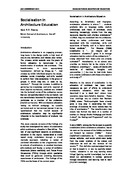| dc.description.abstract | Architecture education is an engaging process; long hours in the design studio, a high level of one-on-one instruction, and intense peer review. The process, which extends over the years of formal education, is instrumental in the transformation of students into architects. This transformation, or more appropriately ‘socialisation’, defined by Bragg as “… that process by which individuals acquire the values, attitudes, norms, knowledge, and skills needed to perform their roles acceptably in the group or groups in which they are, or seek to be, members.”1 Through this process, in addition to garnering the knowledge and skills required of them (explicit curriculum), students are initiated into the [cultural] norms of the profession; norms that are not explicitly stated in the curriculum, but are nevertheless important for anyone seeking to participate as a member of the profession (implicit curriculum). With architecture education having no defined pedagogy, no specific curriculum and no instructional manual, it can be hypothesised that the implicit aspects of architecture education may be significantly influential in the transformation of students into architects.
This paper presents on some of the findings of a study that investigated the nature of socialisation within architecture education in East Africa. The lack of any significant research on architecture education in the region, necessitated a broad
based study, undertaken through a mixed methods approach, including: a review of published information on the programmes; visits to schools of architecture, to conduct interviews with students and faculty; a review of validation documents (where available); and, Focus Group Discussions (FGDs) through which qualitative data could be gathered, providing descriptive experiences of participants. The findings of the FGDs are the focus of the current paper. | en_US |


